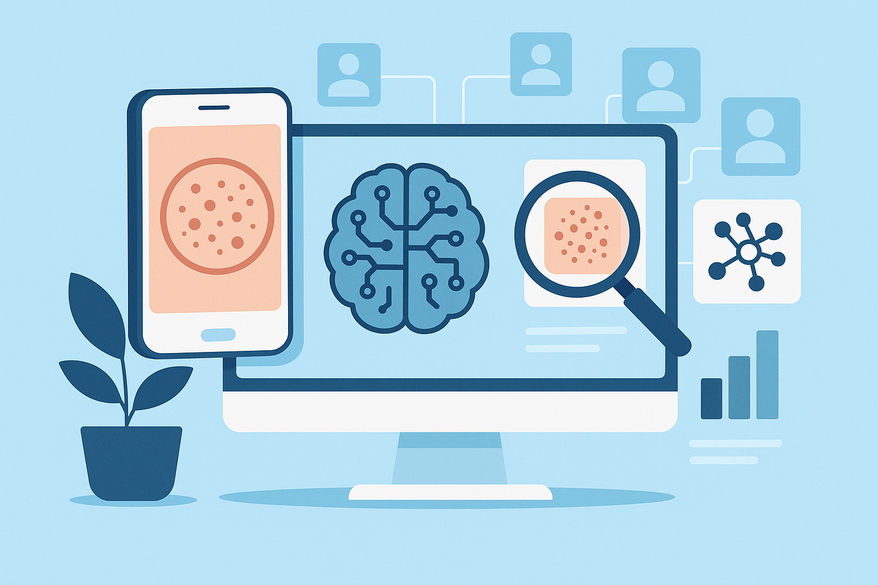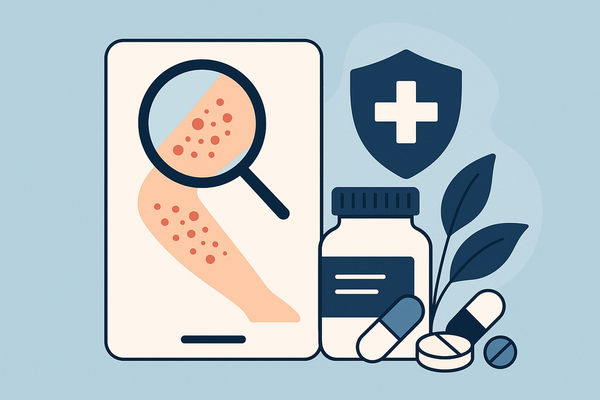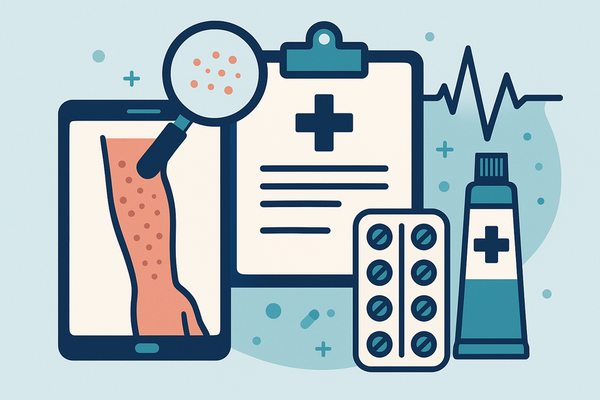How AI Diagnoses Rashes: Transforming Dermatological Care with Machine Learning
Discover how AI diagnoses rashes using image recognition and machine learning, transforming dermatological care by addressing shortages and enhancing accuracy.

Estimated reading time: 7 minutes
Key Takeaways
- Rapid Detection: AI combines image recognition and machine learning to detect skin conditions in seconds.
- Deep Learning Power: Convolutional Neural Networks (CNNs) extract features like color, shape, texture, and borders.
- Robust Preprocessing: Normalization and data augmentation improve model accuracy across varied inputs.
- Clinical Support: Platforms like VisualDx DermExpert guide clinicians with differential diagnoses.
- Ongoing Challenges: Data bias, limited rare-condition examples, and absence of tactile context remain hurdles.
Table of Contents
- Background on AI in Healthcare
- Technical Overview
- Data Collection and Preprocessing
- Diagnostic Workflow
- Accuracy, Challenges, and Limitations
- Clinical Applications and Case Studies
- Future Directions and Ethical Considerations
- Conclusion
Background on AI in Healthcare
Introduction
AI diagnoses rashes by combining image recognition and machine learning to help clinicians spot skin problems faster. AI-driven platforms analyze photographs of rashes and suggest a list of possible conditions in seconds. This matters because many areas face dermatologist shortages and primary care offices need quick triage tools. AI tools scale diagnostics, reduce wait times, and empower non-specialists to make better decisions. Source: VisualDx DermExpert
Evolution of AI in medicine
- Over the last decade, AI has moved from research labs into clinics.
- Visual specialties, like dermatology and radiology, have led adoption because they rely on images.
- General practitioners use AI for quick skin checks. Patients use apps for initial self-assessments (see rash detector app).
Relevance of AI tools
- GPs triage skin issues before specialist referral.
- Patients gain confidence in early self-screening.
- Healthcare systems save time and cost by filtering non-urgent cases.
Technical Overview
Image Recognition Basics
- Input: digital photos of skin taken with smartphones or dermatoscopes.
- Algorithms detect visual features: color variations, lesion shape, texture, borders.
Convolutional Neural Networks (CNNs)
- CNNs are deep learning models with multiple layers.
- Early layers learn simple features like edges and blobs.
- Deeper layers learn complex patterns like ringworm scales or eczema plaques.
- CNNs train on labeled image sets. They adjust millions of parameters via backpropagation.
Source: JMIR study
Data Collection and Preprocessing
Data Types
- High-resolution clinical photographs showing rashes on various body parts.
- Patient demographics: age, gender, skin type, ethnicity.
- Symptom notes: itchiness, pain, duration.
- Medical history: allergies, autoimmune disorders, medications.
Image Normalization
- Resize images to a standard resolution (e.g., 224×224 pixels).
- Convert color space to RGB for consistency.
- Crop to region of interest to remove background noise.
Data Augmentation
- Create synthetic variants: rotate images by 90°, flip horizontally, zoom in/out.
- Adjust brightness and contrast to mimic real-world lighting.
- Augmentation increases dataset size and makes the model robust to varied inputs.
Source: JMIR study
Diagnostic Workflow
- Data Acquisition: Capture clear image via smartphone camera or dermatoscope.
- Preprocessing and Normalization: Automated scripts resize and standardize images.
- Model Training and Validation: Split dataset, train with backpropagation, perform cross-validation.
- Automated Diagnosis and Feedback: Deploy model, compute confidence scores, present ranked differential list.
Accuracy, Challenges, and Limitations
Strengths
- Rapid triage: AI delivers preliminary results in seconds.
- Scalability: Cloud or edge deployment reaches remote clinics.
- Consistency: AI applies the same diagnostic criteria every time.
Limitations
- Data bias: Models may underperform on skin of color if training data lack diversity.
- Rare conditions: Limited examples reduce accuracy.
- Context gap: AI lacks tactile cues and full patient context.
Clinical Applications and Case Studies
VisualDx DermExpert Platform
- Clinician uploads rash image.
- System returns a prioritized differential diagnosis.
- Embedded image library helps verify matches.
- Comparable accuracy to non-expert dermatologists with fewer unnecessary referrals.
Clinicians and patients can also leverage AI tools like the Rash Detector for on-the-go analyses. Below is a sample report:

Future Directions and Ethical Considerations
- Personalized Dermatology: Combine genomic data with image analysis for tailored predictions.
- Human–AI Collaboration: Develop explainable AI that shows which image areas drive each prediction (see best skin tracking app guide).
- Regulatory and Fairness: Follow FDA guidelines, audit performance across demographics, update models continuously.
Conclusion
Artificial intelligence is rewriting the playbook for diagnosing rashes. By leveraging image recognition, convolutional neural networks, and robust preprocessing, AI tools deliver fast, accurate preliminary assessments. They address dermatologist shortages, extend specialist reach, and empower primary care. Yet challenges remain: data bias, lack of tactile context, and ethical concerns around transparency and privacy. The future lies in multimodal AI, personalized dermatology, and explainable systems that keep clinicians firmly in control. Embracing these technologies alongside human expertise promises better skin health for everyone.
Call to Action
Stay informed on the latest AI dermatology research. Explore balanced adoption of AI tools in your practice. Champion data diversity and transparency to maximize patient benefit.
Sources
VisualDx DermExpert
JMIR study
FAQ
- How accurate are AI rash diagnosis tools? Accuracy varies by condition and data quality; top models approach dermatologist-level performance for common rashes.
- Can AI replace dermatologists? AI serves as an assistive tool rather than a replacement. It streamlines triage and augments expert decision-making.
- Is my data safe? Reputable platforms follow HIPAA and regional privacy regulations, anonymize images, and use secure servers.
- How do I choose the right app? Look for clinical validation studies, diverse training sets, and transparent performance metrics.





